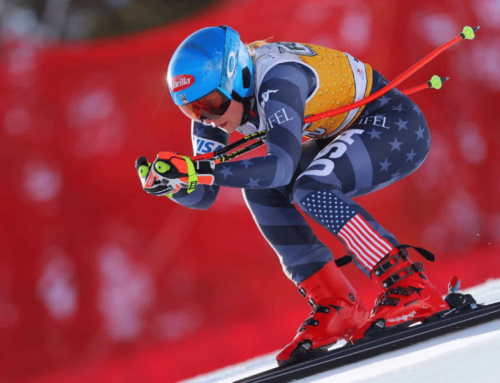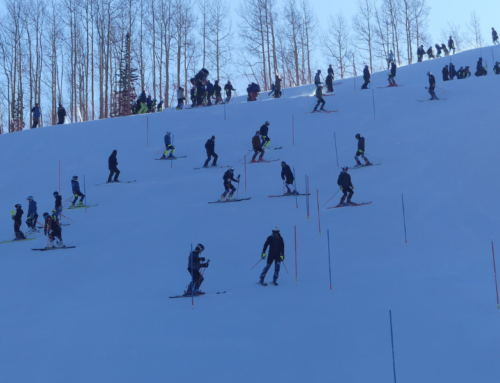QA: U.S. Ski Team speed skier Justin Johnson
Q&A: U.S. Ski Team speed skier Justin Johnson In 1997, Justin Johnson was an up-and-coming teenage speed skier out of Park City, Utah, freshly named to the U.S. Ski Team with a promising World Cup career ahead of him. But after spending two seasons with the national squad, Johnson’s results began to peter out and he was dropped from the team at the end of the ’98 season. He floundered, toiling away on the NorAm circuit, but his dreams of racing Kitzbuehel and Kvitfjell seemed dead in the water. Still, Johnson never gave up on skiing, despite the fact that as every year passed, he drifted further from the U.S. Ski Team’s radar.
In 1997, Justin Johnson was an up-and-coming teenage speed skier out of Park City, Utah, freshly named to the U.S. Ski Team with a promising World Cup career ahead of him. But after spending two seasons with the national squad, Johnson’s results began to peter out and he was dropped from the team at the end of the ’98 season. He floundered, toiling away on the NorAm circuit, but his dreams of racing Kitzbuehel and Kvitfjell seemed dead in the water. Still, Johnson never gave up on skiing, despite the fact that as every year passed, he drifted further from the U.S. Ski Team’s radar.
Then, in 2004 he earned runner-up in the downhill NorAm standings, and a spot back on the U.S. team for the 2004-05 season. The World Cup dream came true last season, seven years (the length of many athletic careers) after his first stint with the team had ended. Johnson took 24th in the downhill at Val Gardena, Italy, earning him a place in his first World Championships downhill where he finished 21st.
After taking two impressive crashes in preparation for the season’s opening World Cups, 28-year-old Johnson took a welcome break from gate training at Copper Mountain, Colorado to speak with Ski Racing.
Ski Racing: What have you been you working on with the speed team in the last few weeks?
Justin Johnson: We got three or four days of GS, so [I’m] just trying to fine-tune the setup. Just working on basically arcing the whole time, not having any dead spots in the turn and running the line a little deeper. Trying to find speed [and] to be as dynamic as possible… I’m trying to push the line and if I miss a gate, that’s actually good for me. Trying to push that limit. So, basically I’ll go and just try and make as many arcs until I blow up. That’s probably why I crashed twice cartwheeled.
SR: What do you find training GS does for your speed events?
JJ: Oh, man. It’s the base for all of them now. It keeps me moving, keeps me in the flow. When I’m skiing not so well, I tend to get really boxy in the hips, just static, so it keeps me honest there. It keeps the flow, everything moving, keeps the dance going.
SR: How do you feel?
JJ: Feeling really confident. After having a year on those [World Cup] downhills last year, and just coming back and finally having all the support of the team. The setup’s all figured out, equipment’s pretty dialed, got a lot of fast skis, so I’m feeling pretty confident.
SR: So what kept you going all those years away from the team?
JJ: Gosh, what was it, seven years in the middle there. I think right after I got dropped, I was more in denial. I was still skiing because that’s what I did. Then I was probably just abusing it a little bit. … I wasn’t giving it my all. I was doing a lot of partying – I guess those were my college years. Burning the candle hard. It’s no wonder I didn’t have an athletic career then.
I guess it was the last Olympic year, and I won a NorAm and I was like, ‘I can still do it.’ I knew I hadn’t give [ski racing] a fair shot – I never put everything into it. I didn’t want to be that guy at 40 who says, ‘I could have been on top of the world.’ That just wasn’t my style. I was like, ‘if I give it everything I can and finish 100th in the world, at least I can move on.’ And sure enough, it’s just been going from there.
SR: Does that experience away from the team help you now that you’re back?
JJ: Traveling around Europe all that time, going to my own seed meetings, doing all that, getting kicked out of races because there’s too many U.S. guys – I can’t count the number of times I quit, saying to myself, ‘I’m done, I can’t do it anymore.’ But yeah, just doing all that, doing all your travel, doing all your rental cars. You learn a lot that way. It makes it fun. When you come back you have a lot more respect for what it’s like [to be on the U.S. Ski Team].
SR: How does that experience affect your current goals?
JJ: It’s a big difference. Before, you always want to make the team, you want to do well, but I had no idea. I was like ‘Whoohoo, great, the national team.’ I was 17 years old, 18 years old.
I always wanted to make it back, but it’s fun now, my whole thinking has changed. It’s not enough, there’s the next step. It doesn’t feel like it’s enough right now just making it back. But at the same time, every next step is a dream come true. Last year, Lake Louise [Johnson’s first World Cup], it was like, ‘if this is the only World Cup I do…’ It’s like getting that one big league at bat after being in the minor leagues all your life, doing it at my age.
SR: When do you reach your next age criteria?
JJ: This year. I have to be on the A team this year. So, I have to be top 30. Pressure’s on.
SR: Do you look to the older guys on the team for inspiration?
JJ: I don’t think age is an issue, especially seeing that the average age in World Cup downhill is right around 30 or 31. …. I think there’s plenty of time, if you stay healthy and keep strong and as long as you’re having fun and you’re motivated. That’s the big thing. I mean, if I stopped having fun, it wouldn’t be worth doing it anymore, especially after all this.
SR: Do you do anything different in training than when you were 18 or 19?
JJ: Yeah, everything. I guess I was never really into the big conditioning thing, I was always a little lazy. When I would have spurts, it was a lot of heavy lifting, static movements. I could squat way more than I could now. Now it’s more plyos, a lot more dynamic, explosive things. I’d have to say Yoga has saved me a bunch – especially with how tight my hips are – just to keep it fluid, and moving and just keeping that strength in different ways, the core strength.
SR: Does the team do yoga or do you do it more on your own?
JJ: We don’t usually do it as a team. I travel with a DVD now, and I just do it in the mornings and stuff. Gets you focused to start the day.
SR: What do you do you think you need to do in order to crack through to the next level?
JJ: The end of last year was great because when we went to Kvitfjell, on the last training day there, I was seventh place until the last intermediate. I missed a gate and then I crashed the next day, but that was a huge breakthrough. It’s the first time I felt I could do something there. Then I just got a ton of results at the end of the year, so I moved my rankings. So I’ll be starting right outside the top 30 in super G – starting 32 – and then downhill – starting 40th . So, I’ve got a lot more confidence there. It feels like I put so many splits on the hill last year – I’d be 60th and then I’d have a top 10 split. After knowing those time and just seeing how this whole show works – because it’s just so different I think I’ll be a little more settled, and less anxious. If I can just put all those splits together, they’ll come together nicely.
SR: You play a lot of golf in the off-season. What’s your handicap?
JJ: Six … with the possibility of shooting in the 90s any day, though.
SR: Who’s the best golfer on the team?
JJ: Nate Roberts, the freestyle skier. Bode will say he’s the best but I’d smoke him any day. You can quote me on that if you want.
SR: Any secrets to keeping the handicap down?
JJ: I take the putter on the road. That’s a lot of strokes right there.





















